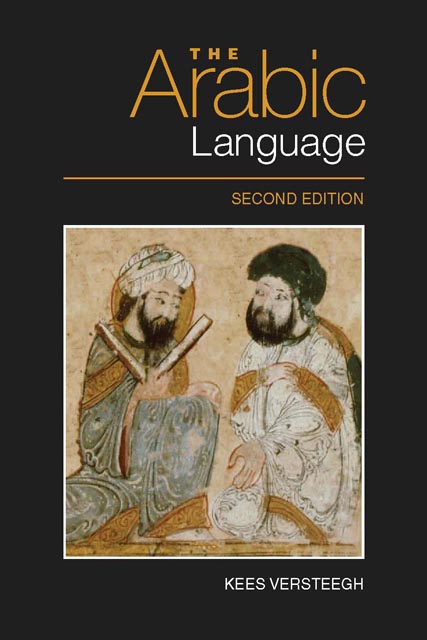Book contents
- Frontmatter
- Contents
- Preface to First Edition
- Preface to Second Edition
- List of Figures and Maps
- List of Tables
- Note on Transcription and Glossing
- 1 The Study of Arabic in the West
- 2 Arabic as a Semitic Language
- 3 The Earliest Stages of Arabic
- 4 Arabic in the Pre-Islamic Period
- 5 The Development of Classical Arabic
- 6 The Structure of Arabic
- 7 The Arabic Linguistic Tradition
- 8 The Emergence of New Arabic
- 9 Middle Arabic
- 10 The Study of the Arabic Dialects
- 11 The Dialects of Arabic
- 12 The Emergence of Modern Standard Arabic
- 13 Diglossia
- 14 Bilingualism
- 15 Arabic as a Minority Language
- 16 Arabic Pidgins and Creoles
- 17 Arabic as a World Language
- Bibliography
- List of Abbreviations
- Index
11 - The Dialects of Arabic
Published online by Cambridge University Press: 18 November 2022
- Frontmatter
- Contents
- Preface to First Edition
- Preface to Second Edition
- List of Figures and Maps
- List of Tables
- Note on Transcription and Glossing
- 1 The Study of Arabic in the West
- 2 Arabic as a Semitic Language
- 3 The Earliest Stages of Arabic
- 4 Arabic in the Pre-Islamic Period
- 5 The Development of Classical Arabic
- 6 The Structure of Arabic
- 7 The Arabic Linguistic Tradition
- 8 The Emergence of New Arabic
- 9 Middle Arabic
- 10 The Study of the Arabic Dialects
- 11 The Dialects of Arabic
- 12 The Emergence of Modern Standard Arabic
- 13 Diglossia
- 14 Bilingualism
- 15 Arabic as a Minority Language
- 16 Arabic Pidgins and Creoles
- 17 Arabic as a World Language
- Bibliography
- List of Abbreviations
- Index
Summary
Dialects of the Arabian peninsula
The Arabian peninsula, the homeland of the Arab tribes,remains the least-known dialect area of theArabophone world. In pre-Islamic times, there wasprobably a division into Eastern and Westerndialects (cf. above, Chapter 4), but subsequentmigrations have changed the geographicaldistribution of the dialects considerably. AllBedouin dialects in this area now belong to the newtype of Arabic, although generally speaking they aremore conservative than the dialects outside thepeninsula in the sense discussed above (Chapter 10,p. 185). In the urban centres of the Gulf themajority speak typologically Bedouin dialects,whereas the Shiʿite minorities speak sedentarydialects.
Recent attempts at classification by Ingham (1982) andPalva (1991) distinguish four groups:
1. North-east Arabian dialects: these are thedialects of the Najd, in particular, those of thelarge tribes ʿAniza and Šammar. This group isdivided into three subgroups: the ʿAnazī dialects(including the dialects of Kuwait, Bahrain (Sunnī)and the Gulf states); the Šammar dialects(including some of the Bedouin dialects in Iraq);and the Syro-Mesopotamian Bedouin dialects(including the Bedouin dialects of North Israeland Jordan, and the dialect of the Dawāġrah, apariah tribe in the northern Sinai littoral).
2. South(-west) Arabian dialects (dialects ofYemen, Hadramaut and Aden, as well as the dialectsof the Shiʿite Baḥārna in Bahrain).
3. Ḥijāzī (West Arabian) dialects: to thisgroup belong the Bedouin dialects of the Ḥijāz andthe Tihāma, which are not very well known; it isnot yet clear what the relationship is betweenthese dialects and those of the urban centres inthis area, chiefly Mecca and Medina.
4. North-west Arabian dialects: these dialectsare classified as a distinct group by Palva(1991); it comprises the dialects of the Negev andthe Sinai, as well as those of southern Jordan,the eastern coast of the Gulf of ʿAqaba and someregions in north-western Saudi Arabia.
In Chapter 10 (p. 187) we have seen that outside theArabian peninsula Bedouin dialects in general arecharacterised by a number of features that set themoff clearly from the sedentary dialects in the samearea (e.g., the voiced realisation of the /q/, theretention of the interdentals, and the genderdistinction in the second- and third-person pluralof the verbs and the pronouns).
- Type
- Chapter
- Information
- The Arabic Language , pp. 192 - 220Publisher: Edinburgh University PressPrint publication year: 2014

